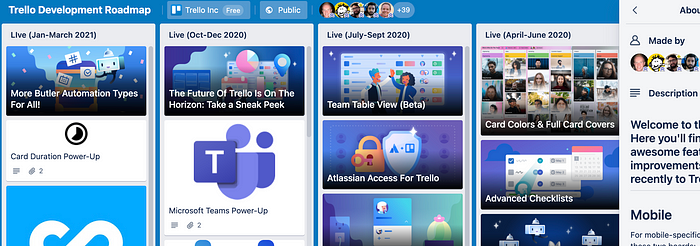Public Product Roadmap? Yes, please!
Check out these Product Companies and their Public Roadmaps

Are you considering making your roadmap public?
Or perhaps you constantly have customers asking about what’s coming up, where things are on the roadmap, etc.
Making your roadmap public might just be a perfect solution depending on your goals.
Many companies have made their roadmaps public and it is a trend that seem to be gaining traction.
There are many benefits to making your roadmap public:
- It builds trust with the market and your users.
- It provides transparency.
- An avenue to communicate with the market and your users.
- It can help compliment your brand.
- It can facilitate more self-service — allowing users to answer questions regarding the roadmap or functionality they would like to see themselves.
- Lead generation.
- ….and more.
However, it can also have downsides:
- An additional roadmap to maintain.
- Competitors can view your roadmap (now you should obviously omit/hide anything sensitive).
- Usually more intensive, more visually pleasing, etc. and therefore takes more effort to create and modify.
- Risk of either changing the roadmap too frequently or not delivering on time, you may set the wrong expectation with customers or lose trust with them after telling them one thing and then doing another.
- …among others.
However the most common concern I hear is “I don’t want our competitors knowing what we’re doing?”
Besides the obvious of omitting sensitive information, my rebuttal is typically this quote:
“If your competitors start copying you then you are doing something right!” — Jay Baer
If you’re always worried about copying your competitors or stopping them from copying you then you’re keeping your eyes on the wrong target.
Watching your competition is important but it’s not where you want to be obsessing. Would you rather be following the competition or getting ahead of them?
If they can easily copy you (and that’s a threat) then you likely don’t have a strong enough competitive advantage.
“Strategy is about making choices, trade-offs; it’s about deliberately choosing to be different.” — Michael Porter
But that aside, if you’re seriously considering making a Public Roadmap or perhaps seeking some inspiration I’ve compiled a list below of some of the different ways I’ve seen companies make their Product Roadmaps public.
1) Public Trello board
No surprise that Trello share their public roadmap via their own tool— Trello Development Roadmap.

Slack also have their API product roadmap public on trello — Slack Platform Roadmap for Developers.

Buffer too — Buffer Transparent Product Roadmap.

….and many more.
A trello board does seem to be the most popular way to present your public roadmap.
2) Public [insert roadmap tool]
Although Trello is immensely popular too to use for your public roadmap there are many other roadmap tools out there where you can share your roadmap publically.
ProdPad — ProdPad Public Roadmap

Roadmap — Roadmap | Our Public Roadmap

Github use their own Kanban tool to communicate their Public Roadmap

Productboard — Productboard Portal | Product Roadmap

….among others
What tool do you use for your roadmap? Do they have a public feature?
3) Add your Roadmap to your website
If you didn’t want to use a specific tool or can’t find a tool that suit your needs, then perhaps consider building it yourself. Consider adding it to your own product/website.
Attendify as an example has added their public roadmap to their website — Attendify|Explore our Product Roadmap

Unity too — Unity Roadmap

….and many. Of course not an exhaustive list.
This is of course more effort but it comes with the benefits of flexibility, fit-for-purpose, unique and containing your branding.
4) Roadmap as its own Product
This Aussie fintech, Up Banking, have easily the coolest public roadmap I’ve ever seen.
Called ‘The Tree of Up’ it is an interactive roadmap where you can actually interact with different parts of the roadmap, read release notes, etc.
You could argue that this is its own product, in its own right.

“The Tree of Up is an interactive, technology tree-like view of the Up product roadmap.”
Hope this has given you some inspiration or even some light food for thought.
I’d be keen to hear about any other types of public roadmaps have you seen?

